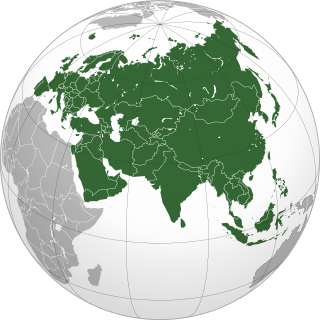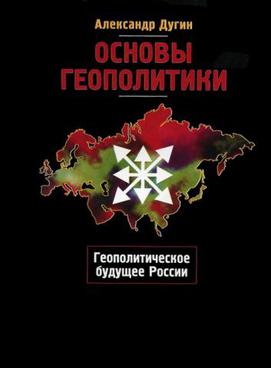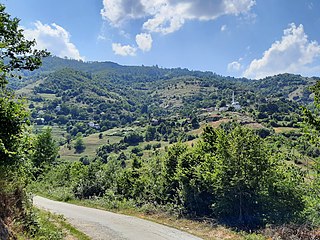Related Research Articles
Geopolitics is the study of the effects of Earth's geography on politics and international relations. While geopolitics usually refers to countries and relations between them, it may also focus on two other kinds of states: de facto independent states with limited international recognition and relations between sub-national geopolitical entities, such as the federated states that make up a federation, confederation, or a quasi-federal system.

The Eurasia Party is a National Bolshevik Russian political party. It was registered by the Ministry of Justice on 21 June 2002, approximately one year after the pan-Russian Eurasia Movement was established by Aleksandr Dugin.

Sir Halford John Mackinder was a British geographer, academic and politician, who is regarded as one of the founding fathers of both geopolitics and geostrategy. He was the first Principal of University Extension College, Reading from 1892 to 1903, and Director of the London School of Economics from 1903 to 1908. While continuing his academic career part-time, he was also the Conservative and Unionist Member of Parliament for Glasgow Camlachie from 1910 to 1922. From 1923, he was Professor of Geography at the London School of Economics.
Geostrategy, a subfield of geopolitics, is a type of foreign policy guided principally by geographical factors as they inform, constrain, or affect political and military planning. As with all strategies, geostrategy is concerned with matching means to ends Strategy is as intertwined with geography as geography is with nationhood, or as Colin S. Gray and Geoffrey Sloan state it, "[geography is] the mother of strategy."

Central Asia has long been a geostrategic location because of its proximity to the interests of several great powers and regional powers.

The Rimland is a concept championed in the early 20th century by Nicholas John Spykman, professor of international relations at Yale University. To him, geopolitics is the planning of the security policy of a country in terms of its geographical factors. He described the maritime fringe of a country or continent; in particular the densely populated western, southern, and eastern edges of the Eurasian continent.

The Torbeši are a Macedonian-speaking Muslim ethnoreligious group in North Macedonia and Albania. The Torbeši are also referred to as Macedonian Muslims or Muslim Macedonians. They have been culturally distinct from the Orthodox Christian Macedonian community for centuries, and are linguistically distinct from the larger Muslim ethnic groups in the greater region of Macedonia: the Albanians, Turks and Romanis. However, some Torbeši also still maintain a strong affiliation with Turkish identity and with Macedonian Turks. The regions inhabited by these Macedonian-speaking Muslims are Debarska Župa, Dolni Drimkol, Reka, and Golo Brdo.

"The Geographical Pivot of History" is an article submitted by Halford John Mackinder in 1904 to the Royal Geographical Society that advances his heartland theory. In this article, Mackinder extended the scope of geopolitical analysis to encompass the entire globe.
In the late 1990s, some journalists used the expression "New Great Game" to describe what they proposed was a renewed geopolitical interest in Central Asia based on the mineral wealth of the region.
Eurasianism is a socio-political movement in Russia that emerged in the early 20th century under the Russian Empire, which states that Russia does not belong in the "European" or "Asian" categories but instead to the geopolitical concept of Eurasia governed by the "Russian world", forming an ostensibly standalone Russian civilization.
The National Assembly of Macedonia was established in 1880, as a reaction to the Congress of Berlin (1878) and composed of 32 representatives from all over Macedonia. The National Assembly of Macedonia established a Provisional Government, which published a Manifesto in 1881. According to the Macedonian historiography the Manifesto expressed Macedonian nationalism, portraying Macedonia as a separate ethnic-nation state with an ancient origin, in particular, an Ancient Macedonian origin.

Eurasia is the largest continental area on Earth, comprising all of Europe and Asia. According to some geographers, physiographically, Eurasia is a single continent. The concepts of Europe and Asia as distinct continents date back to antiquity, but their borders have historically been subject to change, for example to the ancient Greeks Asia originally included Africa but they classified Europe as separate land. Eurasia is connected to Africa at the Suez Canal, and the two are sometimes combined to describe the largest contiguous landmass on Earth, Afro-Eurasia.

The Foundations of Geopolitics: The Geopolitical Future of Russia is a geopolitical book by Aleksandr Dugin. Its publication in 1997 was well received in Russia; it has had significant influence within the Russian military, police, and foreign policy elites, and has been used as a textbook in the Academy of the General Staff of the Russian military. Powerful Russian political figures subsequently took an interest in Dugin, a Russian political analyst who espouses an ultranationalist and neo-fascist ideology based on his idea of neo-Eurasianism, who has developed a close relationship with Russia's Academy of the General Staff.
The Brsjak revolt broke out on 14 October 1880 in the Poreče region of the Monastir Vilayet, led by rebels who sought the liberation of Macedonia from the Ottoman Empire. According to Ottoman sources the goal of the revolt was the accession of Macedonia to Bulgaria. The rebels received secret aid from Principality of Serbia, which had earlier been at war with the Ottoman Empire, until Ottoman and Russian diplomatic intervention in 1881. The Ottoman Gendarmerie succeeded in suppressing the rebellion after a year.

Elovo is a village in the municipality of Studeničani, North Macedonia.

Dolno Količani is a village in the municipality of Studeničani, North Macedonia.
Umovo is an uninhabited village in the municipality of Studeničani, North Macedonia.
Držilovo is a village in the municipality of Sopište, North Macedonia.

Arctic geopolitics is the area study of geopolitics on the Arctic region. The study of geopolitics deals with the "inalienable relationship between geography and politics", as it investigates the effects of the Earth's geography on politics and international relations. Arctic geopolitics focuses on the inter-state relations in the Arctic, which is the northernmost polar region. It is composed of the Arctic Ocean and its adjacent seas, and is home to around four million people. The states in or bordering the Arctic are commonly referred to as the Arctic Eight, and are the United States, Canada, Russia, Finland, the Kingdom of Denmark (Greenland), Norway, Iceland and Sweden.
Energy diplomacy is a form of diplomacy, and a subfield of international relations. It is closely related to its principal, foreign policy, and to overall national security, specifically energy security. Energy diplomacy began in the first half of the twentieth century and emerged as a term during the second oil crisis as a means of describing OPEC's actions. It has since mainly focused on the securitization of energy supplies, primarily fossil fuels, but also nuclear energy and increasingly sustainable energy, on a country or bloc basis.
References
- 1 2 Raffield, B. (2021). "Broken Worlds: Towards an Archaeology of the Shatter Zone". Journal of Archaeological Method and Theory. 28 (3): 871–910. doi: 10.1007/s10816-021-09520-y . S2CID 234870497.
- 1 2 O'loughlin, J. (1999). "Ordering the 'crush zone': Geopolitical games in post‐cold war eastern Europe". Geopolitics. 4 (1): 34–56. doi:10.1080/14650049908407636.
- 1 2 Cohen, Saul (2003). Geopolitics of the World System. Rowman & Littlefield Publishers. p. 43. ISBN 978-0847699070.
- 1 2 3 Gosar, Anton (2000). "The Shatter Belt and the European Core – A Geopolitical Discussion on the Untypical Case of Slovenia". GeoJournal – Spatially Integrated Social Sciences and Humanities. October vol. 52, 2 (2): 107–117. doi:10.1023/A:1013306804212. S2CID 140390836.
- ↑ Hensel, Paul R.; Diehl, Paul F. (January 1994). "Testing empirical propositions about shatterbelts, 1945–76". Political Geography. 13, 1: 33–52. doi:10.1016/0962-6298(94)90009-4.
- ↑ Шаревски, Марио (2017). "Геополитичката положба на Македонија како ранлива точка на балканскиот појас на кршливост во услови на бегалската криза". Геополитичката и геостратегиската положба на Република Македонија во услови на мигрантската и бегалска криза. Македонска академија на науките и уметностите: 159.
- ↑ Humanist (2 October 2015). "Dictionary of Geography: Shatterbelt". Dictionary of Geography. Retrieved 17 May 2021.
- ↑ Nation, R. C. (2015). "Russia and the Caucasus". Connections. 14 (2): 1–12. doi: 10.11610/Connections.14.2.01 . JSTOR 26326394.
- ↑ Cohen, S. B. (1992). "Middle East geopolitical transformation: The disappearance of a shatterbelt". Journal of Geography. 91 (1): 2–10. doi:10.1080/00221349208979330.